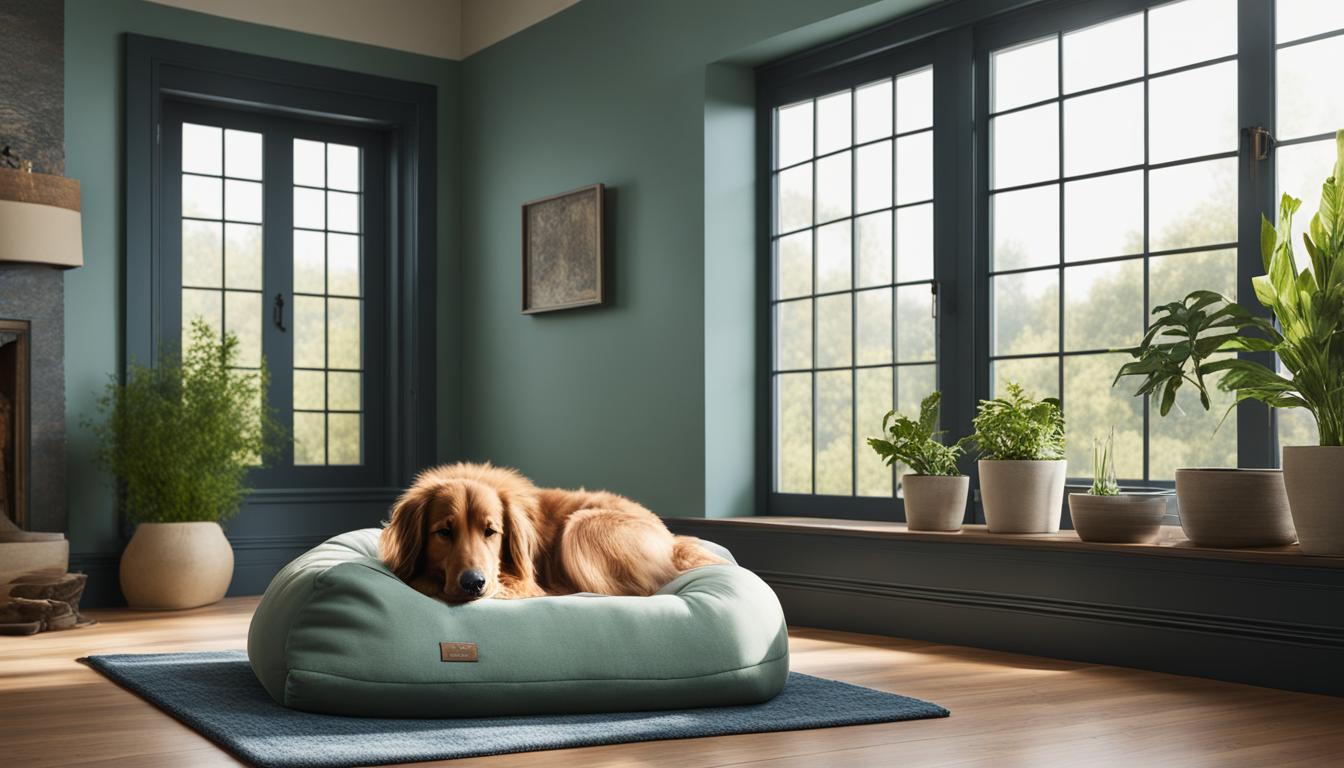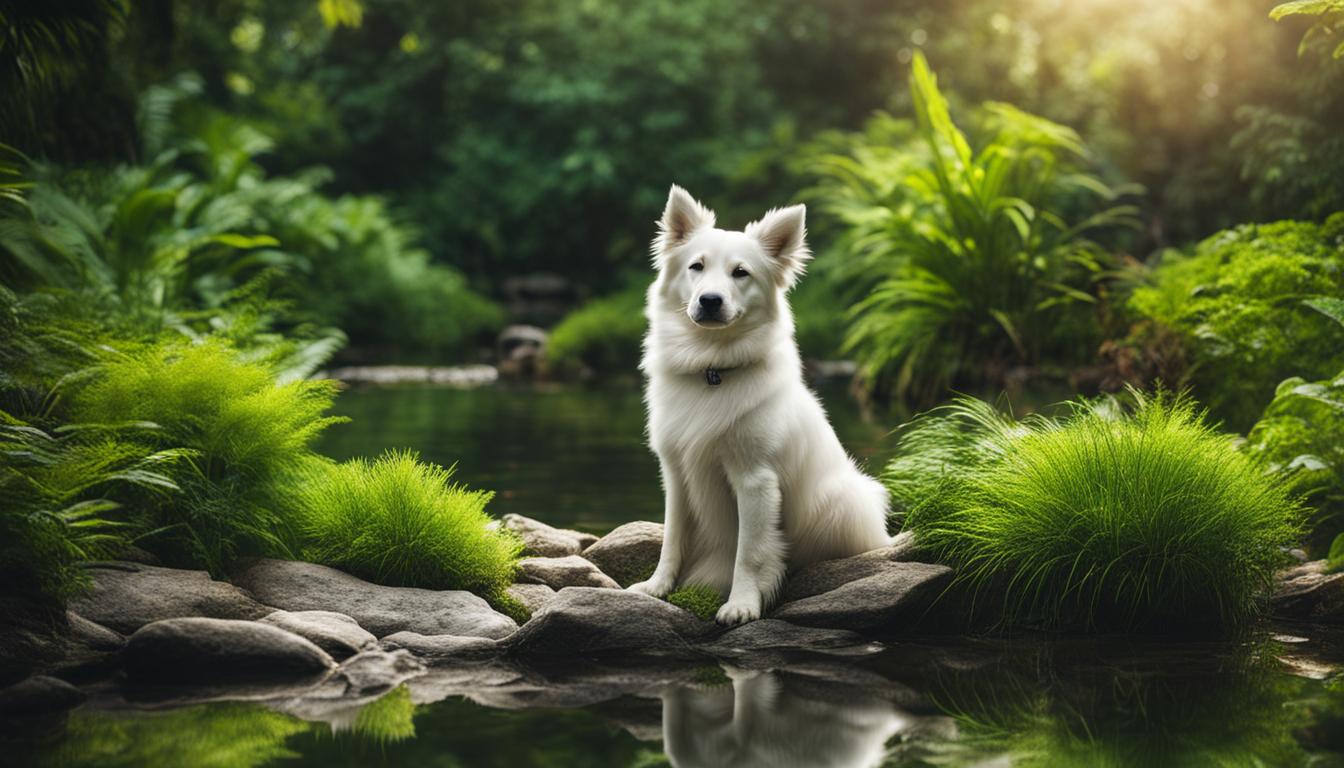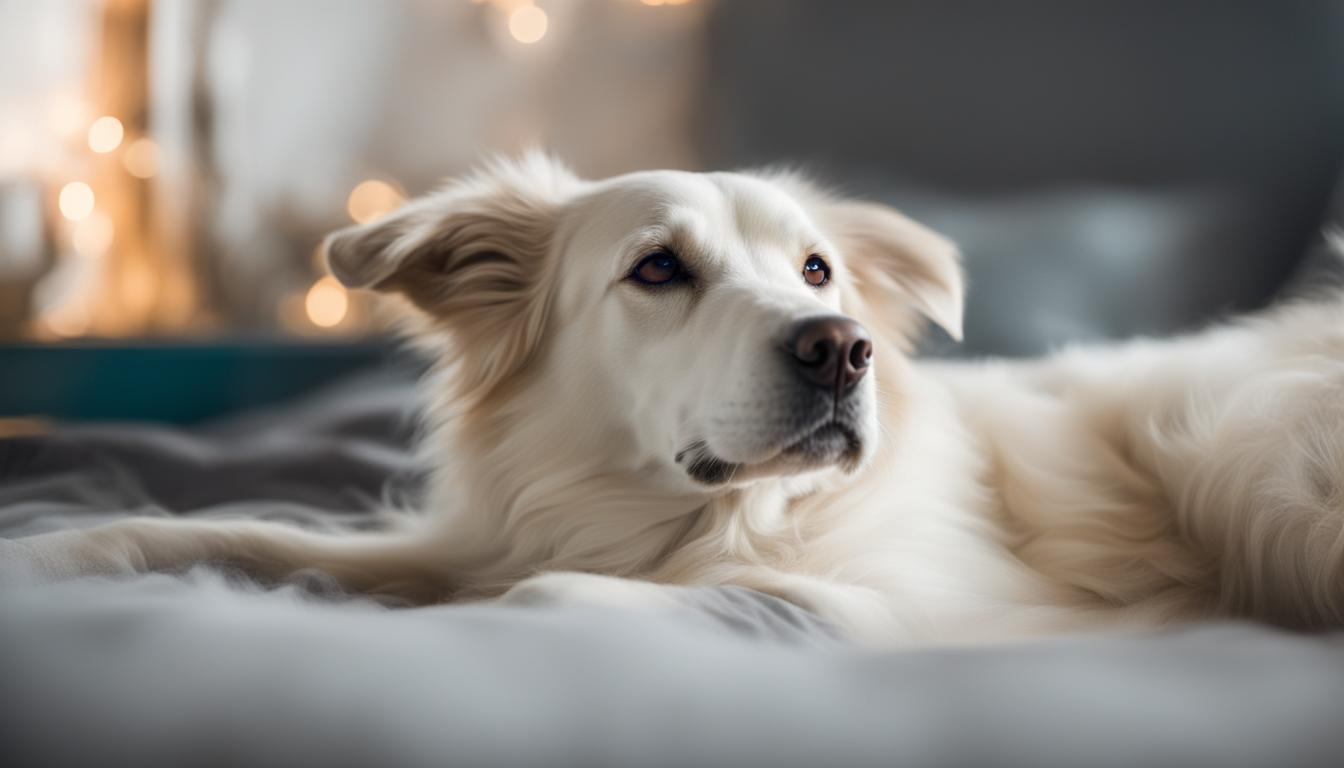Welcome to the world of creating calm environments for anxious dogs! If you have a furry friend who struggles with anxiety, finding ways to help them feel at ease is essential. In this article, we will explore various techniques and approaches to design spaces that promote tranquility and alleviate stress for your beloved pet. From anti-anxiety dog room designs to calming scents, we’ve got you covered!
But first, let’s take a moment to visualize the impact of a serene space. Picture your pup in a cozy room, surrounded by soft furnishings and soothing aromas. Can you see the stress melt away from their eyes? It’s a beautiful sight, isn’t it? Now, let’s dive deeper into the details!
Key Takeaways:
- Creating a calm environment for anxious dogs is crucial for their well-being.
- Zoning the space into different sections can help dogs shift their energy levels.
- Soft furnishings such as plush beds and cushions provide comfort and tranquility.
- Calming scents, like lavender, can have a soothing effect on dogs.
- Consider anti-anxiety dog room designs to cater to your pet’s specific needs.
Sound Management: A Symphony of Serenity
Controlling sound is essential when creating a calm environment for anxious dogs. Noise reduction techniques can help promote a sense of tranquility and reduce stress levels. Acoustic panels are a great solution for absorbing and diminishing noise, creating a more peaceful atmosphere. By strategically placing these panels on walls or ceilings, you can effectively reduce echoes and outside noises that may cause anxiety in dogs.
Another effective method for sound management is the use of calming music. Just like humans, dogs can find comfort in soothing melodies. Calming music, such as soft ambient or classical tunes, has been shown to have a positive effect on dogs, helping them relax and unwind. You can play calming music in the background to create a serene ambiance in your dog’s environment.
In addition to acoustic panels and calming music, white noise machines can also contribute to a peaceful atmosphere for anxious dogs. White noise, like gentle rainfall or ocean waves, can help mask disruptive sounds like barking or loud outdoor noises. By providing a consistent, soothing background sound, white noise machines can promote a sense of calmness and tranquility for dogs.
| Techniques for Sound Management | Benefits |
|---|---|
| Acoustic Panels | – Absorb and diminish noise – Create a peaceful atmosphere |
| Calming Music | – Soothes anxiety in dogs – Promotes relaxation and calmness |
| White Noise Machines | – Masks disruptive sounds – Provides a consistent, soothing background noise |
Creating a serene soundscape is an important aspect of designing a calm environment for anxious dogs. By implementing sound management techniques such as acoustic panels, calming music, and white noise machines, you can create a symphony of serenity that helps alleviate your dog’s anxiety and promotes overall well-being.

Behavior Management: Fostering Peaceful Pups
When it comes to creating a calm environment for anxious dogs, behavior management plays a crucial role. By implementing effective training techniques and providing structured playtimes, you can help your dog develop a sense of calmness and reduce anxiety levels.
One key aspect of behavior management is training for calmness in dogs. Teaching your dog commands like “settle” or “relax” can help them understand how to calm themselves down and shift their energy levels. Practice these commands regularly in a quiet and controlled environment, and reward your dog with treats or praise when they respond calmly.
Another important strategy is staggered playtimes for dogs. Overcrowding in play areas can lead to increased excitement and stress for anxious dogs. By scheduling play sessions in smaller groups or at separate times, you can ensure that your dog has a more relaxed and enjoyable experience. This also allows you to closely monitor their interactions and provide guidance when needed.
Positive reinforcement is a powerful tool in promoting calm behavior. By rewarding your dog for exhibiting calm and relaxed behaviors, you reinforce those behaviors and encourage them to continue. This could be as simple as giving gentle pats or offering treats when your dog remains calm in a stimulating environment. Consistency is key, so be sure to reward your dog consistently for their calm behavior.
| Training for Calmness in Dogs | Staggered Playtimes for Dogs | Positive Reinforcement for Calm Behavior |
|---|---|---|
| Teach commands like “settle” or “relax” | Schedule play sessions in smaller groups | Reward calm behavior with treats or gentle pats |
| Practice commands regularly in a controlled environment | Offer separate playtimes for anxious dogs | Consistently reinforce calm behaviors |
| Use treats or praise as rewards for calm responses | Closely monitor interactions during playtime | Encourage your dog to continue exhibiting calmness |
By incorporating these behavior management techniques into your dog’s routine, you can help create a peaceful and serene environment that promotes their overall well-being.
Sensory Stimulation: Engaging the Senses
In order to create a calm environment for anxious dogs, it’s important to engage their senses in a positive way. Sensory cues can play a significant role in a dog’s mood and overall well-being. By incorporating various elements that stimulate their senses, you can help create a serene atmosphere that promotes relaxation and reduces anxiety.
Aromatherapy for Dogs
Aromatherapy can be a powerful tool in calming anxious dogs. Dog-safe essential oils, such as lavender, can have a soothing effect when diffused in the air. The gentle scent of lavender can help relax their mind and promote a sense of calmness. Simply add a few drops of lavender essential oil to a diffuser, ensuring that it is placed in a safe location where the dog cannot reach it. The subtle aroma will create a serene atmosphere that can help alleviate their anxiety.
Visual Calm for Dogs
Visual stimuli can greatly impact a dog’s emotional state. It’s important to create an environment that minimizes overstimulation and provides a visually calming space for anxious dogs. One way to achieve this is by blocking out overstimulating sights, such as passing cars or busy streets, with the use of curtains or blinds. By reducing visual distractions, you can create a peaceful atmosphere that allows the dog to focus on relaxation.
Tactile Elements for Calmness
Tactile stimulation can also contribute to a dog’s sense of calmness. Introducing comforting textures can help provide a sense of security and relaxation. Soft mats or plush toys can serve as tactile elements that the dog can interact with. These items can provide a soothing touch and a feeling of safety, which can help alleviate anxiety. Creating a designated area with these tactile elements can give the dog a safe space to retreat to when they need to relax.
| Sensory Stimulation Techniques | Benefits |
|---|---|
| Aromatherapy with dog-safe essential oils | Creates a soothing atmosphere |
| Blocking overstimulating sights with curtains or blinds | Reduces visual distractions |
| Introducing comforting textures like soft mats or plush toys | Provides a sense of security and relaxation |
By engaging the senses of anxious dogs through techniques like aromatherapy, visual calm, and tactile elements, you can help create a serene environment that promotes their well-being. Remember, each dog is unique, so it’s important to observe their individual reactions and adjust the sensory stimulation accordingly. With a thoughtful approach to sensory design, you can help alleviate anxiety and create a peaceful space for your furry friend.

Creating a calm environment in a dog daycare requires careful planning and attention to detail. By providing comfortable dog spaces, incorporating DIY calming elements, and setting up a therapeutic room, you can ensure that every furry visitor feels safe, relaxed, and at ease during their stay.
Conclusion
Creating a calm environment for your anxious dog is essential for their overall well-being. By implementing effective techniques like space design, sound management, behavior management, sensory stimulation, maintenance, and monitoring, you can help alleviate your dog’s stress and anxiety.
Remember to consider zoning the area into different sections for play, relaxation, and quiet time, allowing your dog to shift their energy levels. Soft furnishings like plush beds and cushions provide comfort and tranquility. Calming scents, such as lavender, have a soothing effect on dogs and can help create a peaceful atmosphere.
In addition to these techniques, there are various dog anxiety relief products available in the market. These products, including calming sprays, anxiety wraps, and pheromone diffusers, can help create a calming environment for your furry friend. Experimenting with different products can help you find the best solution for your dog’s specific needs.
By prioritizing environmental stress relief for your dog, you can enhance their quality of life and promote a sense of calmness and relaxation. Take the time to understand your dog’s triggers and preferences, and don’t hesitate to seek professional guidance if needed. Remember, a calm and serene environment can make a world of difference for your anxious companion.
FAQ
How can I create a calm environment for my anxious dog?
To create a calm environment for anxious dogs, consider zoning the space into different sections for play, relaxation, and quiet time. Use dividers to separate dogs with different temperaments. Provide soft furnishings like plush beds and cushions for comfort. Consider using calming scents, such as lavender, to soothe dogs.
How can I control sound to create a peaceful environment?
Acoustic panels can absorb and diminish noise, creating a more relaxing atmosphere. Playing calming music, like soft ambient or classical tunes, can have a soothing effect on dogs. White noise machines can also help mask disruptive sounds such as barking.
What strategies can I use to promote calm behaviors in my dog?
Regular training and reinforcement of commands that promote calmness, such as “settle,” can be effective. Staggering playtimes can prevent overcrowding and minimize energy levels. Positive reinforcement, such as treats or gentle pats, can encourage and reinforce calm behavior.
How can I engage my dog’s senses to create a calm environment?
Aromatherapy with dog-safe essential oils like lavender can have a calming effect when diffused in the air. Blocking overstimulating sights, such as passing cars, can reduce anxiety. Introducing comforting textures like soft mats or plush toys can provide dogs with a sense of security.
How can I maintain a calm environment and monitor stress triggers?
Regular breaks are crucial for dogs to rest and rejuvenate. Encouraging staff to provide feedback on stress triggers can help maintain a serene environment. Monitoring noise levels with a decibel meter and making necessary adjustments can contribute to a calm atmosphere.
How can I create a calm environment in a dog daycare?
Provide comfortable spaces with soft furnishings. Introduce DIY calming elements, such as dividers and plush beds. Set up a therapeutic dog room with calming scents and music. Ensuring a serene atmosphere will promote relaxation and reduce anxiety.
How can I find relief for my dog’s anxiety in their environment?
Creating a calm environment is crucial, but there are also various dog anxiety relief products available in the market that can aid in creating a calming environment for dogs. These products include calming supplements, diffusers, and anxiety wraps.





